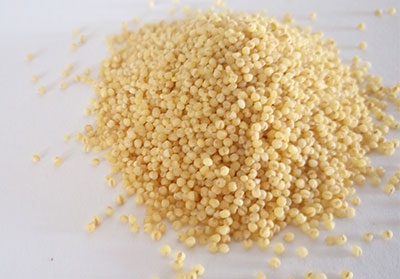
Millet is a naturally gluten-free grain in the Poaceae botanical family. Many cereal grains belong to this botanical family including corn, wheat, rice, and barley.
Numerous varieties exist in a wide range of colors. The most significant ones include pearl millet, finger millet, proso millet, and foxtail millet.
It is thought to be one of the oldest cultivated crops, dating back over 7,000 years.
The majority of millet is grown in India, parts of Africa and China. In the United States, millet is grown in the Dakotas, Colorado and Nebraska.
Purchasing, Selecting, Storing, and Preparing
- Millet is available to purchase in grocery stores year round.
- To prepare a light and fluffy dish, bring 1 cup millet and 2 cups water to a boil. Decrease heat to simmer, cover the millet and cook for about 15 minutes or until water is absorbed. Removed from the heat and let it sit covered for 10 minutes. Then fluff and serve.
- To create a nutty flavor, first toast millet in a saucepan until fragrant. Then add water and cook as above.
- To make creamy porridge use 1 cup millet to 3 cups of water. Bring to boil and simmer covered for 25 minutes or until water is absorbed.
- Store millet in an airtight container in the pantry or store in the refrigerator or freezer for up to two years.
- Use this as a cereal grain, in salads, or add to soups. Millet flour is a great option for gluten-free baking.
Nutrition Information
- Millet is a good source of manganese and magnesium.
- Manganese supports wound healing, and cartilage and bone formation.
- Magnesium assists with blood pressure control, blood sugar regulation and energy production.
Nutrition Facts
Millet ½ cup, cooked
- Calories: 103
- Protein: 3 g
- Fat: 0.87 g
- Carbohydrate: 20.6 g
- Fiber: 1.13 g
- Calcium: 2.6 mg
- Iron: 0.55 mg
- Magnesium: 38.3 mg
- Phosphorus: 87 mg
- Folate: 16.5 µg
- Vitamin A: 0 µg
Via fdc.nal.usda.gov
Recipes
Request an Appointment
